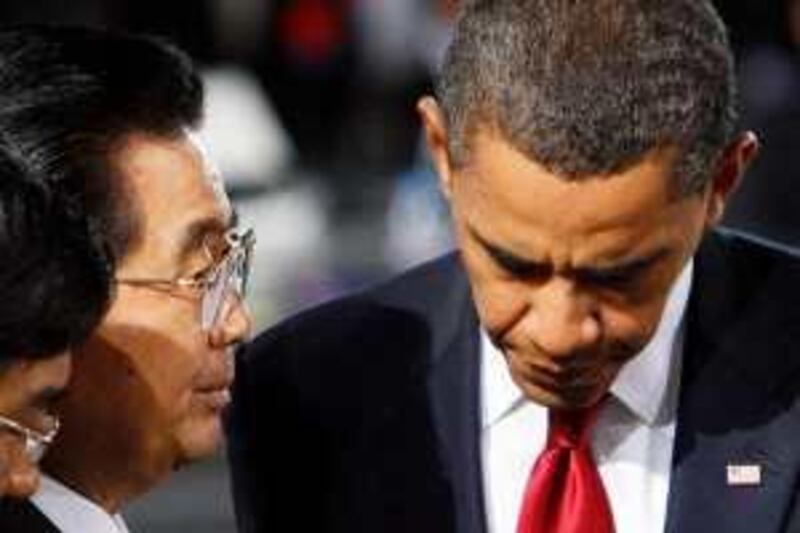Historians may note that on September 24, 2009, China arrived. In Pittsburgh, of all places. There it was at the Group of 20 summit of leading and developing economies (G20), standing indisputably alongside the US - and in some ways, ahead of it - at the dais of global economic leadership. Economists credit the stimulus plan Beijing launched a year ago for a projected economic growth rate of 8.3 per cent this year and a near double-digit expansion next year, when China may well overtake Japan as the world's second-largest economy.
In defiance of dour prophesies - China's minor recession was to produce food riots and political chaos, its recovery destabilising asset bubbles - Beijing is well placed to administer another round of badly needed reforms. Only the lengthening shadow of a trade war obscures China's outlook, and in this Beijing and Washington are co-conspirators. The decision this month by Barack Obama, the US president, to impose tariffs on Chinese-made tyres and Beijing's retaliatory measures only intensified a wanton indulgence of mercantilism worldwide.
Nevertheless, while the US and China are collaborating equally in the abuse of free trade, their fiscal policies are diverging dramatically from each other. While Beijing has over the past 30 years been divesting itself from what was once a monolithically state-run economy, Washington is now the primary shareholder in everything from US car makers to insurance companies. As the US frets about how it will unwind the subsidies and cheap credit that seem to be wrenching its economy from recession, China has already shifted gears by easing up on new lending. While China is at least trying to balance its export-led economy by promoting personal consumption and services, it took a massive recession to lure spendthrift Americans into saving money.
The record deficits assumed by Mr Obama, meanwhile, only build upon the ones he inherited from the previous administration. A close look at the US and Chinese stimulus packages reveals the difference between strategy and tactics in fiscal policy and the implications of neglecting one for the other. Predictably, China's spending plan reflects the priorities of a developing economy with a large population and enormous foreign exchange reserves. At US$585 billion (Dh2.14 trillion), it accounts for a whopping 14 per cent of GDP.
Nearly half the package is earmarked for new infrastructure - railways, highways, airports, power grids - while another 9.3 per cent is invested in rural development, including infrastructure works. The US spending package, at $787bn, represents only 7 per cent of GDP. Nearly half the total consists of tax cuts and bailouts of the country's nearly depleted state treasuries. Just over 10 per cent is allocated for recipients of Medicaid, the government-run health care system for the elderly. The rest is scattered across the vast spectrum of the nation's political economy, from job training, to public schools to law enforcement and public housing repair work. It is an ad hoc plan that is more about stop-gap political needs than it is a blueprint for redemption.
Cleary, this was a deal hammered out between politicians and lobbyists, species as yet unknown to the party plenums of Beijing. There is nothing wrong, or at least nothing illegal, about this. After all, it is as lawful to peddle influence in Washington as it is to openly carry a loaded handgun into a store within 30-minutes drive of Capitol Hill. Unfortunately, by the time the pie was diced up for myriad constituencies and special interests, there was precious little left over for America's brick-and-mortar needs, the foundation of a sustainable economy.
The nation's desperately underfunded infrastructure rated a mere 9 per cent of total spending - public transport rail systems were given a paltry $10bn - while investment for environmental work was allowed only 6.5 per cent. China, which is developing both an energy and an environmental policy that is putting Washington to shame - actually, the US has no energy policy - earmarked nearly 9 per cent of its stimulus to green technology development.
Roughly the size of the continental US in land mass, it has either installed or is scheduled to install 25,750km of high-speed rail lines by 2020. The US, which has less than 800km worth of "high-speed" rail systems - the average clip, at 127kph, is just over half what Chinese trains can do - has no plans, not even a proposal, to expand its network. China is mid-way through what is so far the most successful economic modernisation drive since Japan's Meiji Restoration of the mid-19th century, when a feudal nation fully industrialised within a half-century.
Now it must liberalise its currency to promote consumption and invigorate its still-tiny service sector. It must slowly reduce its foreign exchange reserve, which renders it vulnerable to global economic shocks and it must be prepared for the excess capacity and inventory that will follow once its spending plan has exhausted itself and the economy begins to slow. Beijing has proven over the past three decades that it can be trusted to do what is in its best long-term interests. The same cannot be said of Washington. China, strategically inclined, anticipates events; the US, mired as it is in short-term political expediency, reacts to them.
No points for guessing how this turns out. business@thenational.ae





